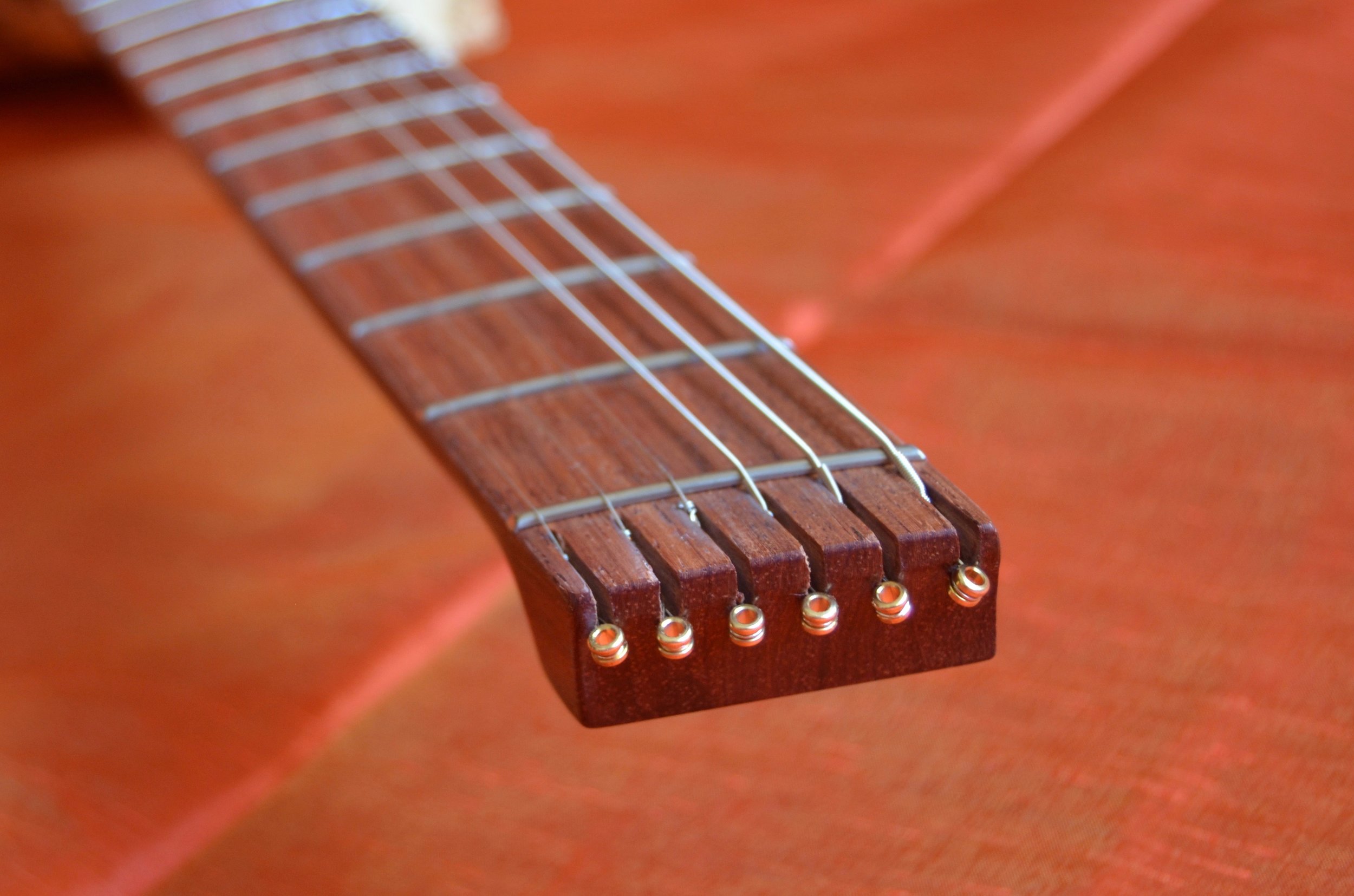I am constantly striving to improve the usability and playability of my guitars. As you can see, I have opted for a headless design on many of my guitars because of the advantages it brings regarding ergonomics and balance. Typically headless guitar tuners use a straight string pull mechanism, whereby the string is anchored to a small block or carriage, which is pulled by turning the head of a captive screw until the string is at the correct tension. Simple enough, but that leaves the other end of the string in need of its own anchoring point. One could use double-ball strings and a simple passive anchor, but most players would prefer to have a greater choice in brands and gauges, which are very limited for double-ball strings. So most makers of headless guitar hardware have opted for a mechanism where the string is fed through a hole or slot, with a set screw set into it perpendicular to the string. Turning the set screw pinches the string and locks it in place:
In the interests of simplifying my own guitars, I was looking for a way to do away with this extra metal locking headpiece. So, why not put the locking mechanism inside the string carriage at the tuner:
I had a batch of these made by Technology for Musicians, an Italian company that makes specialty hardware popular with several high-end luthiers. They allow me to use a separate bridge piece (so they are useable for acoustic instruments) and negate the need for a metal headpiece. Instead, a simple string slot or hole suffices:
I have used them on several guitars so far. From all reports they appear to be working flawlessly. But I have spent enough time as a guitar repair technician to know that if something can break, it eventually but inevitable will, at its weakest point. So I did some destruction testing to find out where and how my design was going to fail.
The weak point of my string carriage design was the size of the set screws used to lock the strings in place. The screw threads (M4 size, stainless steel screws and brass carriages) themselves are very strong, but the tiny hex key used to turn the screw is prone to getting stripped. The high e string in particular requires a fair bit of force to keep it from sliding (it is hardened steel, after all), and this force also risked deforming the string carriage itself at the bottom of the hole. Getting the tiny string into that little hole at the end of the tuner (and it has to be cut to the appropriate length first too) is also a bit of a pain. If trimmed too short, wound strings would tend to slide out slowly under tension, since the set screw would grip the windings more than the core.
In other words, it worked well when used carefully and properly. But I wanted a more robust solution- guitar owners want to be able to change strings without having to be overly cautious and fussy. They just want to get back to playing! So I developed a new way of locking the strings at the bridge that is easer to use, stronger under duress, and easier to manufacture. Introducing Wrap-Lock Headless Tuners:
The principle is simple: instead of pinching the string with the tip of the screw, it is pinched between the head of the screw and the top of the carriage to lock it in place; the string is wrapped at least 180 degrees around the body of the screw before being tightened. Wrap-Lock Headless Tuners consist of the male threaded string lock screw, the female threaded moving carriage, and a surrounding shroud (which may be part of the carriage, or part of the tuner body, or both) which ensures that the string is guided and retained under the screw head before and while the lock screw is tightened.
This configuration provides much more active surface area than the tip of a set screw, which means much less pressure is needed to exert the same amount of friction with the string. Less pressure means less turning force needs to be applied to the lock screw, so there is less likelihood of damaging the hex key while locking the string; additionally, using a regular socket screw means we use a larger hex key to begin with, so it is very unlikely to be stripped even under abusive levels of force. Since the required level of turning force is so much less, those with nimble fingers may substitute a thumbscrew for the hex-head screw, meaning that tools would not be required for string changes at all!
Given that the pressure per unit area is so much less, the carriage is less liable to being worn or embossed by the strings too. And having the string bent around in a semicircle around the screw adds additional resistance to slippage, since the stiffness of the string itself means that it acts as a hook. Furthermore, the action of tightening the screw has the tendency to pull up a small amount of slack in the string. It means the tuners can be very compact since the carriage needs only 1cm of travel, or even less.
In the designs I have made so far using the Wrap-Lock principle, the string lock screw performs a dual function: it also keeps the carriage from rotating as the tuning screw is turned. Many headless tuners that use a cylindrical barrel require an additional pin or screw to do it; eliminating this piece saves time and money, since we don’t have buy the screw, to drill and tap the hole, and cut the corresponding slot. Last of all, this regular socket screw used as the string lock is cheaper, and easier to replace (not to mention harder to lose) than a set screw.
I have already put the Wrap-Lock Tuner into use in different situations. Here they are in a 3-d printed tuning tailpiece for my headless archtop guitar “Breaking Wave”:
And finally, adapted for use with my custom T4M tuner bodies, on my latest Live Edge electric guitar “Blue Gene”:
I will not be applying for a patent for this invention. It is entirely possible that someone else has already come across a similar solution at some point. This would mean it’s possible the Wrap-Lock Tuner principle does not meet the criteria of novelty and non-obviousness anyway, which are necessary in order for a patent to be granted and successfully defended. Patents are expensive and time-consuming to pursue, as well as being expensive to defend. I have decided that it is in everyone’s best interests instead to publish the invention publicly. This means that it is now part of the public domain- I can no longer patent it, but neither can anyone else, thus allowing all luthiers to use the invention freely in perpetuity. I ask only that credit is given where credit is due: if you would like to use your own adaptation of the Wrap-Lock design, I would appreciate a mention of, or a link to, Sankey Guitars.
Enjoy!
UPDATE, April 2023: I have manufactured a batch of wrap-lock tuners and am offering them for sale! You can purchase them here: HEADLESS TUNING MACHINES






